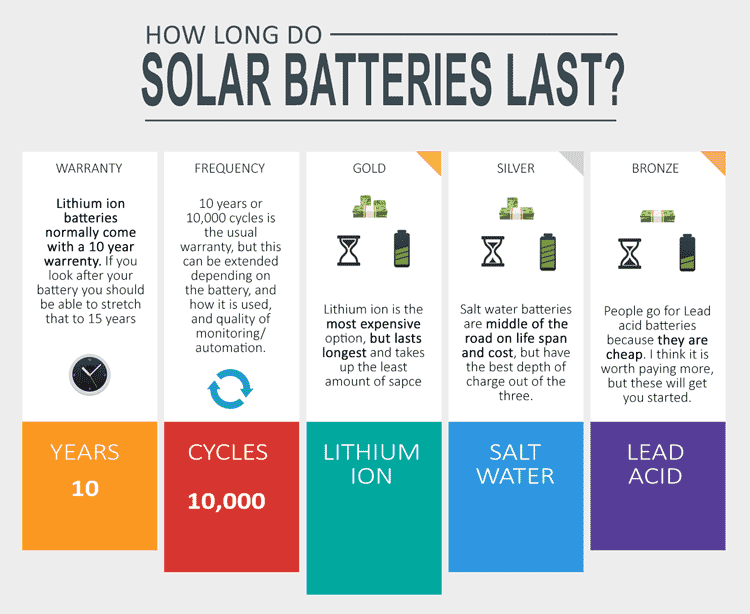Home How long do solar batteries last?
How Long Do Solar Batteries Last?
Choosing the right battery for your solar requirements is super important, buddy. There are three main contenders in the market: **lead-acid**, **lithium iron**, and **saltwater** batteries, each with its own life expectancy. The decision you make significantly influences the outcome, so being clued-up is beneficial. Keep with us, and you’ll discover why opting wisely in this area could be the greatest move you ever make.
Lithium-ion batteries are the gold standard when it comes to solar storage and their warranty period is normally 10 years or 10,000 full cycles. That being said you can expect them to last up to 15 years or more if they are well cared for and maintained.
Batteries can be tricky with some needing “deep-cycles” or being fully discharged before recharging. You don’t want to overcharge them either as it can also deplete their life expectancy. Luckily technology has caught up and the system automatically handles the charge cycles and makes sure it is well balanced for optimum life expectancy.
Table of Contents
ToggleHow long can a solar battery hold a charge?

This will depend on 3 factors:
- Your solar system size
- The battery size
- Your power usage
Batteries are charged when there is excess energy being generated by your solar system but is not being used to power your home. This normally happens during peak periods of sunlight from 10 am to 2 pm.
The time it takes for your battery to charge will depend on the size of your solar system in KiloWatts, the size of your battery, and the rate at which your system is generating electricity. Unless your battery is oversized for your system, you will find it will charge in a day or two.
Once the solar panels can no longer directly run your appliances as the through electricity generation when the sun sets, the battery will pick up the slack. If you are just watching TV and using the oven, you will only use 1 – 2 KW’s of power that evening (including lights, internet, etc. This means even a small battery can easily last all night.
But if you are having a party and running floodlights, 3 fridges and the air conditioner, then you will find you will drain the battery a lot faster.
I cannot give you a time as depending on the use some batteries will last a week without needing a charge. But if you really wanted to you would drain it in a day or two.
When will I need to replace my solar battery?
Your solar battery will need to be replaced at least once in the life cycle of your whole solar system. Solar panels and inverters have a warranty period of about 25 years, whereas a solar battery has a life span of 10 – 15 years or 10,000 cycles, whichever comes first.
As the solar industry as a whole is still quite new at the scale we are seeing, all of the above is really yet to be seen. There are companies who are yet to see their first panel produced to reach a quarter-century, so their life expectancy is based on testing, research and past performance of their competition.
Time will tell with solar panels, but batteries are nothing new and we do know the life cycle of lithium-ion batteries as they are not a new technology, having been around since the ’70s and the trusty old lead-acid batteries commonly used in cars are very predictable indeed.
How do I increase the life of a solar battery?
There are quite a few things that contribute to the degradation of batteries, some are universal across all battery styles and some are specific to the battery’s construction and elements. Let’s have a quick look at the top two.
Lithium iron – These are pretty easy to maintain as unlike other types of batteries they do not have a “memory”. There is no need to do deep cycles so you get the maximum out of them. You can do quick shallow charges, but it is suggested that every 30 cycles you do a deep cycle.
The area where you will come unstuck with Lithium-ion is temperature. They have a preferred operating window, and if they get too hot, they will not hold a charge properly and the battery will also degrade faster. They are best kept in a dry cool place where the temperature does not exceed 30 degrees. The Tesla Powerwall 2 has built-in temperature regulation which makes things a little easier.
Lead-acid – These batteries actually take a bit of maintenance to keep performing at their best and to increase their longevity. Like your car batteries, you will need to check water levels. If they are low you will need to add distilled water as well as electrolytes. You have to be careful not to overfill them and be sure to check them on a regular basis.
Terminal corrosion can also be an issue as well. You will also need to check the cables to make sure they stay well connected. I’m personally having flashbacks to being under the hood of my ’78 HZ Holden.
If you don’t think you are up to the regular maintenance of these batteries you are best going with a maintenance-free version of the lead-acid battery like Gel or AGM.
What size battery will I need for my solar system?
The size of your solar battery will depend on the amount of energy your household will consume in one day and when you use it. The national average in Australia is about 15kWh per day. As most Australians work a typical 9 – 5 job, they are using about 35% of their energy through the day when their solar system is actually producing power and 65% at night.
So what you really need is a battery that can handle your night use. In the above example of the day: night – 35%: 65% we are looking at 5.25kWh through the day and 9.75kWh at night. So you need a battery that can hold at least 10kWh of power to cover you at night.
The Tesla Powerwall 2 holds 13.4kWh so this would more than cover you. They cost about $12,000.
The battery size will depend on what you are looking to get out of your system though. Do you just want to cover your daily power more or less or were you looking fully self-sustained? There are two main types of solar and battery systems, they are grid-ted and off-grid.
Grid-tied – This solar system will have your home still connected to the energy grid just in case you use all your available power and also to feed the extra power you generate back into the system for use. You will still have a battery to store excess energy to use at night or during peak periods, but the battery does not have to be too big as you always have the grid for backup in times of need. Your battery might hold enough charge to cover you for 2 days of your typical energy production.
Off-grid – As the name suggests you will no longer have a connection to the energy grid and you will need to rely 100% on the energy your solar system is producing to cover all your energy needs. This energy will need to sustain you during prolonged periods of rain or cloud cover when energy production is lower. For this, you will need to install an oversized battery that can cover you for 5 – 7 days with little to no energy being produced by your rooftop solar.
So what does that have to do with size of battery?
If you are just trying to eliminate your power bill as much as possible is probably best going with a battery backup that will cover you for your night usage and stay connected to the grid just in case it rains or there are a few days of sub-optimal weather such as cloudy where energy production drops.
On the other hand, if you were looking to go fully off-grid you will need to have enough power backed up in battery storage to last you for up to 5 days of low power generation by your system. It’s a little bit riskier as things happen and if you had a few weeks of bad weather you could find yourself with every little power.
A full off-grid system is also going to be a lot more expensive as you will need a lot of batteries to back up the amount of power you will need.
Types of solar batteries
There are 3 main types of batteries utilized by the solar industry and also a couple of dark horse options worth considering.
Lithium-ion solar batteries
These are the gold standard when it comes to solar batteries. They are lightweight, compact, and are the most efficient. This is why you find them on your mobile phone. They are just a better battery. But that being said they are also the most expensive. The most well-known solar battery on the market is the Tesla Powerwall which uses Lithium-ion batteries. These batteries also have the longest lifespan of all the batteries and a good depth of charge.
lead acid
These types of batteries we have been using in cars for decades are nothing new. As they are made at scale for the automobile industry they are by far the cheapest option for solar but are sub-optimal when it comes to lifespan and depth of charge. They are currently being used in solar, but I don’t think they will be for much longer as the Lithium-ion and saltwater batteries production ramps up[ and their costs begin to drop. They are really only still a player because of their price.
Saltwater batteries
A newcomer to the solar storage party, saltwater batteries although cheaper and a lot safer than their acid and lithium counterparts as they have no toxins and are not flammable, they don’t quite perform at the high standards of power output needed for home use. With a poor lifespan, inconsistent power output, and reduced round-trip efficiency, we will need to wait to see how this technology develops before calling it a real player in the solar storage space.

Solar battery maintenance for longer life
You can easily get you lead acid or Lithium-ion batteries lasting 50% longer than the warranty period by following a few maintenance techniques to make sure your battery is performing at its best and to avoid degradation.
Battery bank size planning
You are best installing the whole battery bank in one go rather than adding to battery capacity over time. Solar batteries are available in sizes 1.5kWh right up to 16kWh. You might think of starting small, then upgrading later by adding to your battery bank. This can have a negative effect on all your batteries as battery voltage response changes with age. After 1 year it is already too late to add more batteries no matter what your solar installer is trying to convince you of.
Also, remember to buy high-quality batteries. Do your research as you really do get what you pay for when it comes to solar batteries.
Clean terminals of corrosion
Prevention is always better than a cure as once corrosion sets in it is hard to keep on top of and it spreads easily. Be sure to paint all corrosive surfaces with a non-hardening sealant to all terminals. If you are past that and you are reading this after having your battery installed for some time, then not to worry.
To clean terminals use a mixture of baking soda and distilled water with a battery terminal brush (which is just a fine wire brush). Once finished coat the terminals with a metal sealant or a high-temperature grease. When you do the first spot some corrosion build-up, it is important to clean asap and check every 4 to 6 weeks to keep on top of it. You are producing and storing your own energy, and not paying someone to do all of this for you (the energy companies). It may feel like a lot of work but 10 minutes 5 – 10 times per year is a small price to pay for free power.
Full cycle batteries every month
Although Lithium-ion batteries do not have the memory it is still important to give them a full cycle every 30 cycles or each month whichever comes first. Bringing batteries to a full state–of–charge (SOC) once per month reduces internal corrosion and equalizes all battery cells. Some cells do lag behind at times so bringing them all up to speed each month is important. This is all easily done from your mobile phone these days with your battery system monitor.
Temperature moderation
This is an area where the technology is yet to catch up. When a solar battery is too cold -5 degrees or lowers it is unable to properly charge resulting in a reduction of kWh storage and output. If the temperature gets too high you run the risk of your battery overcharging which becomes dangerous and will have a negative impact on the amount of charge it will hold and its longevity. To prevent this most manufacturers recommend keeping batteries in a spot that does not go outside the extremes of
Use a system monitor
Every solar system and battery comes with an app to monitor and control lots of different things to do with your system. In the case of batteries, the app can show you things like current battery capacity, whether it is charging or discharging, and lots of other useful information. Certain battery makers and apps will also allow quite advanced options to customize your power to suit your particular usage habits. A lot of the necessary things such as deep cycling are done automatically by most modern solar battery packs.
Table of Contents
Toggle




